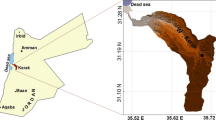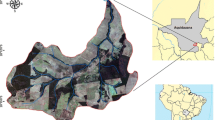Abstract
Soil erosion is one of the major threats to the conservation of soil and water resources. For that reason, predictive erosion models are useful tools for evaluating soil erosion and developing soil erosion management plans. For this aim, the revised universal soil loss equation (RUSLE) function is a widely used erosion model. This research integrated the RUSLE with a geographic information system (GIS) to investigate the spatial distribution of annual soil loss potential in the Alaca catchment in north central Black Sea region, Turkey. The rainfall erosivity factor was developed from local annual precipitation data using a modified Fournier index; the topographic factor was developed from a digital elevation model; the land cover factor was generated from satellite imagery and forest inventory maps; and the soil organic carbon level and the erodibility factor were developed from systematically collected soil samples and the application of the geostatistical method, respectively. From the model, more than the half of the total study area was in the very low and low erosion risk classes (0–12 t ha−1 year−1), whereas 4.4 % (723.6 h) of the total area was at high and very high erosion risk (35–150 and >150 t ha−1 year−1), respectively. In addition, soil organic carbon density values were between 0.18 and 4.92 kg m−2 across the catchment. Moreover, the distribution of soil organic carbon losses was closely correlated with the distribution of soil erosion risk classes in the study area. Soils and topographical properties of the watershed had a greater influence than land use/land-cover type on the magnitude of potential soil and soil organic carbon losses, because the erosivity factor did not change substantially in the study area.








Similar content being viewed by others
References
Arnoldus HMJ (1980) An approximation of the rainfall factor in the universal soil loss equation. In: De Boodt M, Gabriels D (eds) Assessment of erosion. Wiley, Chichester, pp 127–132
Başkan O, Dengiz O (2008) Comparision of traditional and geostatistical methods to estimate soil erodibility factor. Arid Land Res Manag 22:29–45
Bayramin İ (1998) İntegrating digital terrain and satellite image data with soils data for small scale mapping of soils. PhD thesis, Purdue University Agronomy Department, p 121
Bayramin İ, Dengiz O, Baskan O, Parlak M (2003) Soil erosion risk assessment with ICONA model, case study: Beypazari area. Turk J Agric For 27:105–116
Bergsma E, Charman P, Gibbons F, Hurni H, Moldenhauer WC, Panichapong S (1996) Terminology for soil erosion and conservation. International Society of Soil Science, Grafisch Service Centrum, Wageningen
Boggs G, Devonport K, Evans K, Puig P (2001) GIS-based rapid assessment of erosion risk in a small catchment in the wet/dry tropics of Australia. Land Degrad Dev 12:417–434
Burrough PA (1986) Principles of geographical information system for land resources assessment. Oxford University Press, Oxford
Çanga MR (1985) Toprak ve su koruma. Atatürk Üniversitesi Ziraat Fakültesi Yayınları No 1386 Ders Kitabı No 400 (in Turkish)
Csafordi P, Pödör A, Bugc J, Gribovszki Z (2012) Soil erosion analysis in a small forested catchment supported by ArcGIS model builder. Acta Silv Lign Hung 8:39–55
Dengiz O, Saglam M, Türkmen F (2015) Effects of soil types and land use-land cover on soil organic carbon density at Madendere Watershed. Eurasian J Soil Sci 4:82–87
Edwards JA, Koval EJ, Lendt BW, Ginther PG (2008) Distribution system model development and maintenance using GIS, guidelines and recommended procedure. Black and Veatch internal whitepaper, Kansas City
Eedy W (1995) The use of GIS in environmental assessment. Impact Assess 13:199–206
Gee GW, Bauder JW (1986) Particle-size analysis. In: Klute A (ed) Methods of soil analysis part 1 physical and mineralogical methods, vol 9, part 1, 2nd edn. American Society of Agronomy, Madison, WI, pp 383–441
Gertner G, Wang G, Fang S, Anderson AB (2002) Effect and uncertainty of digital elevation model spatial resolutions on predicting the topographical factor for soil loss estimation. J Soil Water Conserv 57(3):164–182
Guggenberger G, Zech W, Thomas RJ (1995) Lignin and carbohydrate alteration in particle size separates of an Oxisol under tropical pastures following native savanna. Soil Biol Biochem 27:1629–1638
Hickey R (2000) Slope angle and slope length solutions for GIS. Cartography 29(1):1–8
İrvem A, Tülücü K (2004) Coğrafi bilgi sistemi ile toprak kaybı ve sediment verimi tahmin modelinin (est) oluşturulması ve Seyhan-Körkün alt havzasına uygulanması. Çukurova Üniversitesi Fen Bilimleri Enstitüsü Dergisi 13 (in Turkish)
İrvem A, Topaloglu F, Uygur V (2007) Estimating spatial distribution of soil loss over Seyhan River Basin in Turkey. J Hydrol 336:30–37
Jackson ML (1958) Soil chemical analysis. Prentice Hall Inc., Englewood Cliffs
Jones RJA, Montanarella L (2003) Land degradation. The JRC Enlargement Action, Contributions to the International Workshop Soil and Waste Unit Institute for Environment & Sustainability Joint Research Centre European Commission Ispra 21020 Italy, p 333
Kemper WD, Rosenau RC (1986) Aggregate stability and size distribution. In: Klute A (ed) Methods of soil analysis part 1 physical and mineralogical methods, vol 9, 2nd edn. Agronomy, Madison, pp 425–442
Kinnel PIA (2001) Slope length factor for applying the USLE-M to erosion in grid cells. Soil Tillage Res 58:11–17
Klute A, Dirksen C (1986) Hydraulic conductivity and diffusivity. In: Klute A (ed) Methods of soil analysis part 2 agronomy, vol 9. Am Soc Agron Inc, Madison, pp 687–732
Lillesand TM, Kiefer RW (2000) Remote sensing and image interpretation, 4th edn. Wiley, New York
Lu D, Li G, Valladares GS, Batistella M (2004) Mapping soil erosion risk in Rondonia, Brazilian Amazonia: using RUSLE, remote sensing and GIS. Land Degrad Dev 15:499–512
Martin A, Gunter J, Regens J (2003) Estimating erosion in a riverine watershed, Bayou Liberty-Tchefuncta River in Louisiana. Environ Sci Pollut Res 4:245–250
Meyer LD (1980) Soil conservation problems and prospects. In: Morgan RCP (ed) International Conference on Soil Conservation the Natural College of Agricultural Engineering, Silsoe Bedford, UK
Millward AA, Mersey JE (1999) Adapting the RUSLE to model soil erosion potential in a Mountainous Tropical Watershed. Catena 38:109–129
Ministry of Agriculture, Forestry and Villages (1987) General management planning of turkey (soil conservation main plan). Ministry of Agriculture Forestry and Villages, General Directorate of Rural Services, Ankara, p 105
Onori F, De Bonis P, Grauso S (2006) Soil erosion prediction at the basin scale using the revised universal soil loss equation (RUSLE) in a catchment of Sicily (southern Italy). Environ Geol 50:1129–1140
Ouyang D, Bartholic J (2001) Web-based GIS application for soil erosion prediction. In: Proceedings of an International Symposium—Soil Erosion Research for the 21st Century, Honolulu, HI, 3–5 Jan 2001, pp 260–263
Pla I (2008) Desertification under climate change and changing land use in Mediterranean environments. In: Gabriels D, Cornelis W, Eyletters M, Hollebosh P (eds) Combating desertification assessment adaptation and mitigation strategies. UNECO Chair of Eremology Ghent University, Belgium, pp 30–40
Renard KG, Foster GR, Weeies GA, Porter JP (1991) RUSLE: revised universal soil loss equation. J Soil Water Conserv 46:30–33
Renard K, Foster G, Weesies G, McCool D, Yoder D (1997) Predicting soil erosion by water: a guide to conservation planning with the revised universal soil loss equation (RUSLE). USDA Agr Handbook No 703. United States Department of Agriculture, Agriculture research Service, Washington, DC
Reusing M, Schneider T, Ammer U (2000) Modeling soil erosion rates in the Ethiopian Highlands by integration of high resolution MOMS-02/D2-stereo-data in a GIS. Int J Remote Sens 21:1885–1896
RIVM (2000) Technical report on soil degradation. RIVM report 481505018, Bilthoven
UNCCD (2015) United Nations convention to combat desertification. Living Land 192, UNCCD and Copublisher. ISBN: 978-92-95043-24-4. http://www.unccd.int/en/resources/publication/Pages/default.aspx
Van Remortel RD, Maichle RW, Hickey RJ (2004) Computing the LS factor for the revised universal soil loss equation through array based slope processing of digital elevation data using C++ executable. Comput Geosci 30:1043–1053
Wang G, Gertner G, Fang S, Anderson AB (2003) Mapping multiple variables for predicting soil loss by geostatistical methods with TM images and a slope map. Photogramm Eng Remote Sens 69:889–898
Wischmeier WH, Smith DD (1965) Predicting rainfall erosion losses from cropland east of the Rocky Mountains: guide for selection of practices for soil and water conservation planning. USDA agriculture handbook. US Government Printing Office, Washington
Wischmeier WH, Smith DD (1978) Predicting rainfall erosion losses—a guide to conservation. Agricultural handbook 537. Planning Science and Education Administration US Dept. of Agriculture, Washington, p 58
Yang D, Kanae S, Oki T, Koikel T, Musiake T (2003) Global potential soil erosion with reference to land use and climate change. Hydrol Process 17(14):2913–2928
Acknowledgments
The authors thank Gregory T. Sullivan for editing the English in an earlier version of this manuscript.
Author information
Authors and Affiliations
Corresponding author
Rights and permissions
About this article
Cite this article
Imamoglu, A., Dengiz, O. Determination of soil erosion risk using RUSLE model and soil organic carbon loss in Alaca catchment (Central Black Sea region, Turkey). Rend. Fis. Acc. Lincei 28, 11–23 (2017). https://doi.org/10.1007/s12210-016-0556-0
Received:
Accepted:
Published:
Issue Date:
DOI: https://doi.org/10.1007/s12210-016-0556-0




